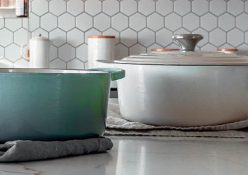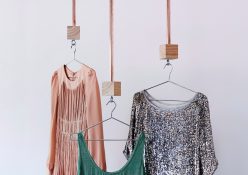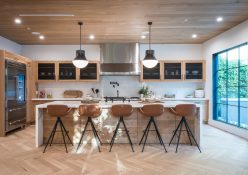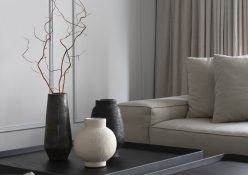This greenhouse masterpiece, which is built on a farm near Pretoria, is completely off the grid and melts into its surrounds
When architect Nadine Engelbrecht built a home for her parents on a farm outside Pretoria, not only did she bring the outside in with a double-volume conservatory at its centre, but she also took the house off the grid.
The house sits on a 35-hectare farm with rocky, hilly grasslands and views of the nearby Bronberg mountain range. At first, the house appears to be referencing a barn-like structure or gesturing towards some sort of grand agricultural design, but that wasn’t Nadine’s primary concern.
‘It’s not supposed to look like a barn,’ says Nadine. ‘It’s just supposed to be a shell.’ When she first started sketching designs for her parents, Charmaine and Andre, she asked her mother to show her a picture of something she liked. Her mother produced a picture of a farmhouse in the Karoo. It was a stone cottage with a roof made of corrugated iron sheeting. ‘I asked her what she liked about it and she said she didn’t know,’ says Nadine. Her mother also showed her an idyllic tearoom in a conservatory that she liked.
Baffled, Nadine went back to the drawing board. And then the penny dropped. ‘I realised my mom wanted simplicity,’ she says. ‘Nothing that’s trying to look like “architecture”, but something that creates beautiful space and light.’
So Nadine took the simplest form she could imagine – the archetype of a child’s drawing of home – and honest, humble materials, and started there. She designed a steel and glass facade, exposed concrete slabs and cement-washed brick walls. The durable metal roof sheeting, she says, was a practical, rather than aesthetic choice, interspersed with polycarbonate, which lets in natural light. ‘We wanted to keep it rough and natural, like it belongs here,’ says Nadine. Timber accents throughout soften the industrial materials and provide a sense of warmth.
The house was positioned to capture views to the north and south, and overlooks a nearby grove of trees to the west, for her bird-loving father. ‘From the main bedroom, you look right into the treetops,’ she says.
The voluminous central conservatory was for her plant-loving mother, who grows all sorts of green delights such as orchids, cymbidiums and a variety of air plants.
This barn-like space is at the very centre of the home. The heart of many traditional South African homes – like the Karoo cottage Nadine’s mother showed her – is a covered front stoep. The long, warm summers and mild winters make indoor-outdoor living a foregone conclusion. ‘My mom wanted a closed patio so she could have soft furnishings – and also for it not to be a room next to the house, but in the house,’ explains Nadine. So, this became the core of the home – their conservatory.
To one side is a kitchen and an informal-seating-area-cum-TV-room. To the other, a lounge, his-and-hers glassed-in office spaces, and a bedroom.
Downstairs, tucked into the hillside, is a self-contained guest suite for visitors: ‘Two bedrooms and bathrooms, and a shared little kitchenette and lounge area,’ says Nadine.
Close to Nadine’s heart is the notion of passive design, energy efficiency and sustainability. ‘In South Africa, because of the climate, if you design a house well, you don’t need alternative heating and cooling,’ she explains. The farm has three dams, which take care of its water supply, and she incorporated 16 solar panels on the roof to cover most of the electrical power requirements.
‘Everything but the oven,’ Nadine says. It’s carefully insulated. ‘Our overhangs are correct, so in the wintertime sun comes into the house,’ she says. ‘In summer, if you keep the doors open, it cools naturally – it’s never too hot. When everything is open, it breathes, and the temperature stays constant.’
As well as being a plant lover, Charmaine is a champion of local art and design. She frequents student exhibitions, often buying the works of upcoming artists to support them. Almost all the furnishings throughout the house are by local designers. The modern wooden chandelier above the dining table is by David Krynauw. In the lounge, there’s a bench by Laurie Wiid van Heerden, a table by Gregor Jenkin and Ronel Jordaan chairs.
The dining table was designed by Nadine and made by her father, who is a keen amateur carpenter, and also contributed to the woodwork in various spaces, such as the custom-made steel kitchen island. Pre-loved classroom chairs found at an antique store were restored and used at the dining room table, while other pieces were salvaged from the original farmhouse, situated elsewhere on the farm.
This spacious home is an eclectic mix that is beautifully executed in the simple palette of white walls, timber, concrete and steel carried throughout the home. The au naturel landscaping was largely a matter of rehabilitating the natural grassland in the surrounds of the house, and then introducing some other water-wise varieties on the many inclines where heavy rains would have washed out grass. ‘We’ve got some lawn for the dogs and kids to play on,’ says Nadine.‘Otherwise, everything is regional.’
Subscribe to Livingspace, to receive monthly updates on all decor trends.







